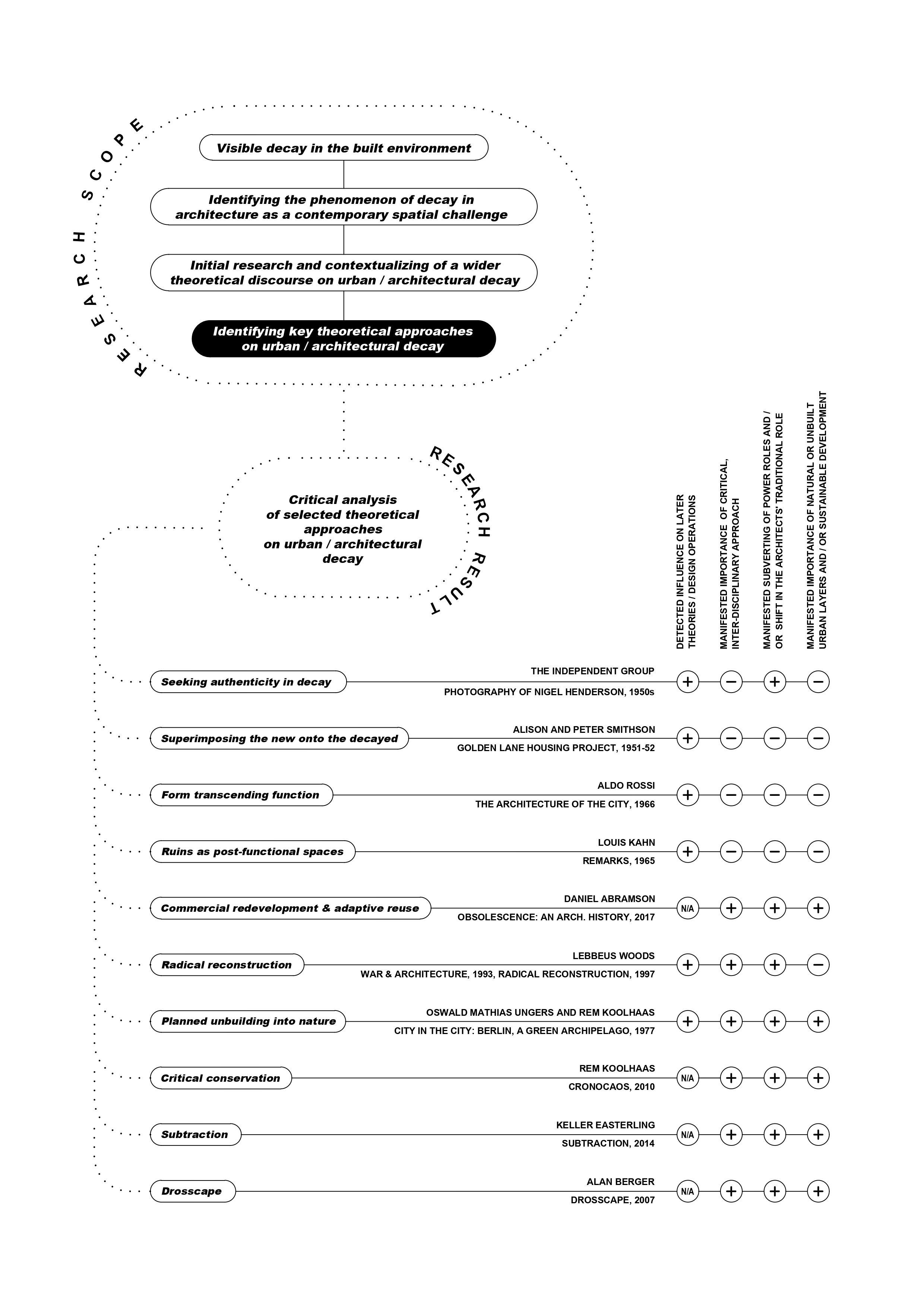On the Phenomenon of Decay in Architecture
Theoretical Perspectives from the 1950s to the 2020s
DOI:
https://doi.org/10.31522/p.31.2(66).3Keywords:
adaptive reuse, architectural ruin, building decay, building obsolescence, urban transformationAbstract
Derelict, dilapidated buildings in various states of ruin have always been present in our built environment. Theoretical approaches to the issue of ruins within the field of architecture have been changing continuously in response to shifting social, political, economic, and cultural conditions. Although origins of the debates on ruins can be traced centuries back, the topic came into focus with renewed intensity following the mass destruction in the wake of World War II. This paper discusses relevant perspectives on the phenomenon of decay in architecture from the 1950s to the 2020s, and offers a critical synthesis of their diverse viewpoints, thus enabling further formulations of contemporary positions and design strategies concerning this increasingly significant subject matter.
References
Accordino, J., Johnson, G. T. (2000) ‘Addressing the Vacant and Abandoned Property Problem’. Journal of Urban Affairs 22/3, pp. 301–315. https://doi.org/10.1111/0735-2166.00058
Abramson, D. (2017) Obsolescence: An Architectural History, Chicago: The University of Chicago Press. https://doi.org/10.7208/chicago/9780226313597.001.0001
Berger, A. (2007) Drosscape: Wasting Land in Urban America, New York: Princeton Architectural Press.
Easterling, K. (2014) 'Subtraction' in Hirch, N. and Miessen, M. (eds.) Critical Spatial Practice 4, Berlin: Sternberg Press.
Frampton, K. (1985) Modern Architecture: A Critical History, London: Thames and Hudson.
Giedion, S. (1959) Space, Time and Architecture (Third, enlarged edition), Cambridge: Harvard University Press.
Hertweck, F., Marot, S. (eds.) (2013) The City in the City, Berlin: A Green Archipelago, A Manifesto (1977) by Oswald Mathias Ungers and Rem Koolhaas, Zürich: Lars Müller Publishers.
Hill, J. (2020) ‘Architecture in the Dark’ in Butcher, M. and O’Shea, M. (eds.) Expanding Fields of Architectural Discourse and Practice: Curated Works from the P.E.A.R. Journal. London: UCL Press.
Hollander, J., Kirkwood, N., Gold, J. (2010) Principles of brownfield regeneration: cleanup, design, and reuse of derelict land, Washington: Island Press.
Jokilehto, J. (2006) A History of Architectural Conservation, Oxford: Butterworth-Heinemann. https://doi.org/10.4324/9780080523118
Jukić, T., Smode Cvitanović, M. (2011) Zagreb – gradski projekti u postupku planiranja grada, Zagreb: Arhitektonski fakultet Sveučilišta u Zagrebu i Gradski ured za strategijsko planiranje i razvoj Grada.
Kahn, L. (1965) 'Remarks', Perspecta, 9/10, pp. 330–331. https://doi.org/10.2307/1566926
Koolhaas, R. (2011) “Cronocaos”, Log, 21, pp. 119–23.
Lončar, S., Pavić, D. (2020) 'Areas with Abandoned and Vacant Properties in Croatia. A Plea for Recognition, Research, Policies and the Development of Regeneration Strategies', Etnološka tribina, 50(43), pp. 197-237. https://doi.org/10.15378/1848-9540.2020.43.09
Lowe, S. (2012) ‘Abandonment’ in International Encyclopaedia of Housing and Home, Smith, S. J. (ed.) Amsterdam, Oxford, Waltham: Elsevier. https://doi.org/10.1016/B978-0-08-047163-1.00511-7
Lowenthal, D. (2014) “Conservation Past and Present”, Sylvester Baxter Lecture at the Harvard GSD [Online]. Available at: https://issuu.com/criticalconservation-harvardgsd/docs/cc_lowenthal_transcript [accessed: 7 October 2023].
Lyons, S. (2018) Ruin Porn and the Obsession with Decay, London: Palgrave Macmillan Cham. https://doi.org/10.1007/978-3-319-93390-0
Marić, T., Bojanić Obad-Šćitaroci, B. (2012) ‘Walkspace; Linearno povezivanje prostora na primjeru Splita’ Prostor, 20 (1(43)), pp. 118-131.
Matković, I., Jakovčić, M. (2019) 'Brownfield prostori i njihova regeneracija: Definicije i pristupi', Prostor, 27(2 (58)), pp. 348-359. https://doi.org/10.31522/p.27.2(58).13
Modrčin, L., Bilić, A. N., Rupnik, I., Woods, L. (2001) Intervju: Lebbeus Woods, Oris 9 [Online]. Available at: http://www.oris.hr/hr/casopis/clanak/[69]intervju-lebbeus-woods,958.html [accessed: 23 November 2022].
Modrčin, L., Prpić, L., Wagner, A. (2021) Lebbeus Woods: Zagreb Free Zone Revisited, Zagreb: Faculty of Architecture, University of Zagreb and Oris House of Architecture.
Mumford, E. (2002) The CIAM Discourse on Urbanism, 1928-1960, Cambridge: The MIT Press.
Newton, P. W. (2010) ‘Beyond Greenfield and Brownfield: The Challenge of Regenerating Australia’s Greyfield Suburbs.’ Built Environment, 36(1), pp. 81-104. https://doi.org/10.2148/benv.36.1.81
Palich, N. et al. (2011) ‘Glossary of Environmentally Sustainable Design’, Environment Design Guide, 70, pp. 1-24.
Rossi, A. (1984) The Architecture of the City (translated by Ghirardo, D. and Ockman, J.), Cambridge: The MIT Press.
Ruskin, J. (1903) The Seven Lamps of Architecture in Cook, E.T and Wedderburn, A. (eds.) The Complete Works of John Ruskin, London: George Allen.
Špikić, M. (ed.) (2018) Gustavo Giovannoni: Spomenici i ambijenti, Zagreb: Matica hrvatska.
Vitruvius, M., Morgan, M. H. (1960) Vitruvius: The Ten Books on Architecture. New York: Dover Publications.
Woods, L. (1993) War and Architecture, New York: Princeton Architectural Press.
Woods, L. (1997) Radical Reconstruction, New York: Princeton Architectural Press.
*** Commodity, firmness, and delight: the ultimate synthesis [Online]. Available at: https://www.britannica.com/topic/architecture/Commodity-firmness-and-delight-the-ultimate-synthesis [accessed: 11 May 2023.].
*** Critical Conservation Program, Harvard University Graduate School of Design [Online]. Available at: http://blogs.gsd.harvard.edu/critical-conservation/ [accessed: 08 February 2023].
*** “Never demolish. Always transform, with and for the inhabitants”: Anne Lacaton delivers inaugural Jaqueline Tyrwhitt Urban Design Lecture [Online]. Available at: https://www.gsd.harvard.edu/2022/04/never-demolish-always-transform-with-and-for-the-inhabitants-anne-lacaton-on-urban-design-and-architecture/ [accessed: 08 September 2023].

Downloads
Published
How to Cite
Issue
Section
License
Copyright (c) 2023 Jana Horvat, Karin Šerman

This work is licensed under a Creative Commons Attribution 4.0 International License.
Copyright (c) 2021 authors and journal.
This work is licensed under a Creative Commons Attribution 4.0 International License.
Authors who publish with this journal agree to the following terms:
In agreeing this form, you certify that:
- You read the ethical codex of the PROSTOR available at journal web.
- You submitted work is your original work, and has not previously been published and does not include any form of plagiarism.
- You own copyright in the submitted work, and are therefore permitted to assign the licence to publish to PROSTOR.
- Your submitted work contains no violation of any existing copyright or other third party right or any material of an obscene, libellous or otherwise unlawful nature.
- You have obtained permission for and acknowledged the source of any illustrations, diagrams or other material included in the work of which you are not the copyright owner.
- You have taken due care to ensure the accuracy of the work, and that, to the best of your knowledge, there are no false statements made within it.
- All co-authors of this submitted work are aware of, and in agreement with, the terms of this licence and that the submitted manuscript has been approved by these authors.






